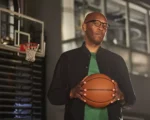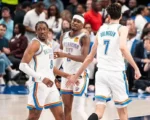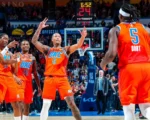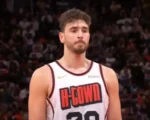There is no offseason in the NBA. Before the Finals have even ended, we already have a blockbuster trade that sent Desmond Bane to Orlando in exchange for Kentavious Caldwell-Pope, Cole Anthony, four first-round picks, and a pick swap. That deal also slightly altered mock drafts, with pick 16 heading to Memphis, giving the Grizzlies a first-round pick.
That doesn’t guarantee that they’ll hold that pick; they could certainly swing it to another team over the next nine days before the draft begins. Every rumor has indicated that this will be a busy offseason, so it isn’t surprising that it got started early.
The official draft withdrawal date has officially passed, and a few international prospects, such as Neoklis Avdalas, Ben Henshall, and Momo Faye, withdrew and will reportedly evaluate their options for next season to help improve their stock ahead of the 2026 draft. That leaves the depth of this draft even thinner.
Still, there is a ton of talent at the top, and this is how our team thinks the 2025 draft will go with a little over a week before it begins on June 25.
Round 1
1. Dallas Mavericks
Cooper Flagg, F, Duke
For all the talk about Flagg’s high ceiling coming into this draft — MVP candidate, top-five player in the league for a stretch — what’s more important is his high floor. That starts with the fact that Flagg is a high-motor, competitive defender whose rim-protecting skills have always been his strength. Flagg is likely a multi-time All-Star at worst. That’s what makes his selection such a no-brainer. – Kurt Helin, NBC Sports
2. San Antonio Spurs
Dylan Harper, G, Rutgers
The obvious choice here for the Spurs is Harper, even if they have multiple talented guards on the roster. He’s just that good. It’ll be interesting to see how head coach Mitch Johnson utilizes Harper in the rotation with De’Aaron Fox and Stephon Castle, but Harper has too much upside as a prospect for San Antonio to pass on. He will form a dangerous duo with Victor Wembanyama that could last for at least a decade. – Noah Rubin, Rotoworld
3. Philadelphia 76ers
V.J. Edgecombe, G, Baylor
In the eyes of many, the draft begins with the 76ers at No. 3. While Philadelphia may move down in the draft, staying put could net the team an attractive piece for the future. Rutgers’ Ace Bailey is a possibility, but so is the ultra-athletic Edgecombe, who would provide a dimension the current 76ers’ perimeter rotation lacks. The 6-foot-5 guard does not need the ball in his hands to be impactful on offense, and defensively, he’s a high-level competitor. Edgecombe does need to become a more efficient offensive player, but Philadelphia has the talent to compensate for that. – Raphielle Johnson, Rotoworld
4. Charlotte Hornets
Ace Bailey, F, Rutgers
The Hornets need more talent. A lot more talent. Bailey has the second-highest ceiling of any player in this draft with the build and look at times of a prototypical NBA wing. If he can be that guy and thrive in the spacing of the NBA game — and playing off LaMelo Ball — the Hornets may have a key piece of the future. – Helin
5. Utah Jazz
Jeremiah Fears, G, Oklahoma
The Jazz have experimented with multiple point guards in recent years, and while Isaiah Collier had a strong rookie year, he wasn’t good enough for Utah to avoid drafting another lead ball handler. Fears’ efficiency was an issue during his lone season at Oklahoma, but he was productive in a high-usage role in a tough conference after enrolling a year early. The 18-year-old has the potential to solve the point guard problem for the Jazz. – Rubin
6. Washington Wizards
Khaman Maluach, C, Duke
While the Wizards did select Alexandre Sarr with the second overall pick in last year’s draft, he’s more of a modern big who likes to spend equal time on the perimeter and in the paint. Therefore, adding Maluach would not be an issue if he’s still on the board. Just 18 years old, the 7-foot-2 center out of Duke is excellent in the paint on both ends of the floor. Maluach will need time to develop, which should not be an issue for a Wizards franchise that fully embraced a rebuild last season. – Johnson
7. New Orleans Pelicans
Kon Knueppel, G, Duke
Whatever the Pelicans roster looks like after Joe Dumars is done tinkering with it this summer, it will need more shooting and guard depth. Knueppel fills those roles. Shooting is his strength — he hit 40.6 percent of his three-pointers last season for the Blue Devils — and he can do some secondary shot creation, while also being a solid defender. He can step right in and give Willie Green some minutes. – Helin
8. Brooklyn Nets
Tre Johnson, G, Texas
This is just the start of a long rebuild for Brooklyn, and Johnson would be an excellent piece to add. He is one of the best shooters and scorers in the draft and will immediately provide the Nets with a potential franchise player. He’ll have a chance to develop other aspects of his game over the next few seasons, but the scoring should be there from day one. Though Flagg will be the heavy favorite, Johnson would be a dark horse candidate to win Rookie of the Year in a situation like Brooklyn. – Rubin
9. Toronto Raptors
Derik Queen, C, Maryland
Current starting center Jakob Poeltl has one guaranteed season remaining on his current contract, with a player option for 2026-27. While teams don’t usually go for need in the draft, this is a spot where the Raptors can do so while also getting the best available player on the board. Queen is a versatile big who boasts a polished offensive skill set that still has ample room for growth. His perimeter shot improved late in his lone season at Maryland, and there’s also the ability to facilitate for others. Queen does need to improve defensively, but having Poeltl will give the Raptors time to develop the rookie on that end of the floor. – Johnson
10. Houston Rockets (via PHX)
Kasparas Jakucionis, G, Illinois
The Rockets are expected to extend Fred VanVleet this summer, but they need some point guard depth behind him and Jakucionis can be that guy. He’s a strong floor general who understands how to run an offense, is a creative passer, and averaged 15.6 points, 5.6 rebounds and 4.8 assists a game last season. Ultimately, how good he is depends on his shooting and defense, but he’s going to be in the NBA for a long time. – Helin
11. Portland Trail Blazers
Noa Essengue, F, Ratiopharm Ulm, France
Essengue is still playing for Ratiopharm Ulm right now, so he wasn’t able to attend the NBA Draft Combine. However, he had some measurements done recently that put him at 6-10 without shoes on, which is a bit taller than expected, along with nearly a 7-1 wingspan. He’s not a ball-dominant player, and he does a little bit of everything else, which will help him fit in right away with Portland’s young core. He will provide them with another formidable perimeter defender on the wing, and Scoot Henderson should be able to find him for some easy shots at the rim. If the Trail Blazers want to turn a corner this year, Essengue can contribute immediately, but he also won’t turn 19 years old until December. – Rubin
12. Chicago Bulls
Collin Murray-Boyles, F, South Carolina
With long-time starter Nikola Vucevic and backup Zach Collins both entering the final season of their respective contracts, there may be an added sense of urgency to add a young big to the fold. The Bulls can do that here by selecting Murray-Boyles, a versatile frontcourt player who can be used at power forward or center. The basketball IQ, tenacity and defensive ability help compensate for Murray-Boyles’ lack of height, and the Bulls have the scorers (and in Vucevic, a floor-spacer) needed to cover for his limited perimeter shooting. – Johnson
13. Atlanta Hawks (via SAC)
Danny Wolf, F, Michigan
Onyeka Okongwu is the starting center in Atlanta, and with Clint Capela almost certainly gone via free agency, the Hawks want some depth at the five. Wolf gives them that. He has a strong feel for the game with guard-like passing skills. He may not defend well enough (or be explosive enough as an athlete) to be a starting five, but he has an NBA role. – Helin
14. San Antonio Spurs (via ATL)
Carter Bryant, F, Arizona
Bryant has been a late riser in this class, and there is a decent chance he goes earlier than this when the draft rolls around next week. However, San Antonio would be thrilled if the board fell like this. Bryant didn’t play a large role at Arizona, but the upside here is tremendous, especially on defense. With Wembanyama healthy, the Spurs will be looking to return to the playoffs next season. Bryant has the ability to contribute early on defensively, with upside to turn into much, much more. – Rubin
15. Oklahoma City Thunder (via MIA)
Egor Demin, G, BYU
Do the Thunder need another point guard? Probably not, especially with 2024 first-round pick Nikola Topic due to be available after sitting out this season with a torn ACL. However, Demin is the best available player on the board, and he has the size to play multiple positions. How successful he is at the NBA level will depend on his perimeter shot, which needs a lot of work. The good news here is that Oklahoma City has enough talent to remain patient in developing Demin. – Johnson
16. Memphis Grizzlies (via ORL)
Thomas Sorber, C, Georgetown
Memphis has this pick as one of the stunning four first-round picks it got in the Desmond Bane trade. That trade also gave the Grizzlies good guard depth (with the additions of Kentavious Caldwell-Pope and Cole Anthony), so they may look for more help along the front line. Sorber is a bit undersized for an NBA center (6-9) but his 7-6 wingspan and strong NBA build will allow him to play inside, and he has a good feel for the game. – Helin
17. Minnesota Timberwolves (via DET)
Cedric Coward, G, Washington State
Coward only played six games last season before a torn labrum ended his year early. He committed to transfer to Duke next season, but his name rose up draft boards, and he opted to forego another year in college. Based on the number of other players that opted to return to school and enjoy NIL money while improving their draft stock, Coward wouldn’t have done that if he wasn’t going in the first round. He boasts a 7-2 wingspan, and he’s a knockdown shooter. He should immediately provide Minnesota with yet another two-way wing. – Rubin
18. Washington Wizards (via MEM)
Jase Richardson, G, Michigan State
Considered by some to be a lottery pick early in the pre-draft process, Richardson’s measurements at the combine negatively impacted how he’s viewed in some circles. While he does not possess the size most teams prefer off-ball scorers to have, the former Michigan State standout has the offensive skill set required of a combo guard. While the Wizards added Bub Carrington to the mix in last year’s draft, the team is still in rebuilding mode. And if Richardson is available here, Washington would be hard-pressed to leave him on the board. – Johnson
19. Brooklyn Nets (via MIL)
Liam McNeeley, G/F, Connecticut
The Nets head into the draft needing… everything. McNeeley thrived at Montverde Academy (on the same team as Flagg and Queen) but was pushed into a role as a primary shot creator for Dan Hurley and the Huskies, which was not a fit. The Nets are betting he can return to his high school form and be part of their wing rotation. – Helin
20. Miami Heat (via GSW)
Nique Clifford, G, Colorado State
Every year, it feels like there is a pick that is a match made in heaven for the Heat. It usually ends up being a tough, two-way player who can contribute immediately. Clifford feels like that guy this year. At 23 years old, he doesn’t have the same room for growth that some of the other players in this class do, but he should be at least a rotation piece from day one, with the upside to start as a rookie. Miami isn’t going to kickstart a rebuild this year, and adding Clifford will help them improve the roster. – Rubin
21. Utah Jazz (via MIN)
Maxime Raynaud, F/C, Stanford
The 7-1 Raynaud is one of the most skilled big men in this draft class. During his time at Stanford, the All-ACC center showed off the ability to score from all over the floor, and his rebounding improved as his career progressed. While the Jazz appear to have their center of the future in Walker Kessler, he’s not the most skilled big man offensively. Adding Raynaud would give Utah a floor-spacer in the frontcourt, especially if they were to move John Collins via trade. – Johnson
22. Atlanta Hawks (via LAL)
Joan Beringer, C, Cedevita Olimpija, France
As noted above when I had them drafting Wolf out of Michigan, the Hawks need depth at the five. Beringer is more of a long-term bet. He showed potential as a shot-blocking, rim-running big in the Adriatic League last season, but he’s a project. Atlanta is betting on its player development skills here. – Helin
23. Indiana Pacers
Asa Newell, F/C, Georgia
Once unanimously considered to be a lottery talent, the opinions on Newell have changed. He can still be a phenomenal player, but he may need the right situation for that to happen. Indiana feels like the perfect place for that. He’s not much of a shot creator, but the Pacers’ style of play will get him easy looks. He’s not a great defender, but he’ll have Myles Turner behind him to clean things up. Newell also fills some gaps for the Pacers as a backup center that can also spend time at power forward if they want him to. – Rubin
24. Oklahoma City Thunder (via LAC)
Nolan Traore, G, Saint-Quentin, France
Initially projected to be a lock for the draft lottery, Traore’s limited perimeter shooting is an issue for some draftniks. However, he’s a quick point guard who can be a high-level playmaker for others, provided he keeps the turnovers in check. Oklahoma City certainly doesn’t need another point guard, but Traore on the board at this point could be too enticing to pass up. – Johnson
25. Orlando Magic (via DEN)
Will Riley, G/F, Illinois
While Orlando moved into a “win now” mode by trading for Bane, Riley is the best player on the board and a bet by the Magic on their player development and long-term success. The Magic believe in the Riley we saw score 22 points on 12 shots in a win against Xavier in the NCAA tournament (and ignore the times he faded into the background of games this season). – Helin
26. Brooklyn Nets (via NYK)
Drake Powell, G, UNC
The Nets have a ton of needs, but with Nic Claxton, Noah Clowney and Day’Ron Sharpe on the roster, they do have some centers with upside. That’s why it isn’t an issue for them to select wings with three of their four first-round picks, even if they opt to address different positions on draft night. Powell played a limited role at North Carolina after entering as a five-star freshman, but he boasts a 7-0 wingspan and a 43-inch vertical. He still has upside as a creator on offense, but it was his 37.9 percent shooting from beyond the arc and his defensive prowess that make him a strong selection for the Nets. – Rubin
27. Brooklyn Nets (via HOU)
Walter Clayton Jr., PG, Florida
The Nets have embraced the rebuild, and point guard is a position of need, regardless of what happens with D’Angelo Russell in free agency. So, why not add a point guard who led his team to a national title and can make plays for himself and others? Despite being considered by some to be a bit small for an NBA point guard, Clayton would fit that mold. There’s room for him to grow as a finisher, but adding a quality leader with a championship pedigree can work out well for a rebuilding franchise. – Johnson
28. Boston Celtics
Hugo Gonzalez, G/F, Real Madrid, Spain
The Celtics can afford to be patient (not like anyone they were going to draft here was going to come into this veteran team and make a big impact). Gonzalez has good size and feel for the game, and shows real promise as a defender, he has the kind of game that would fit well on the Celtics (or Pacers, or a lot of deep teams), but the question is his shot. He hit just 29 percent from deep last season. Don’t be surprised if he spends another year in Spain working on that before coming over. – Helin
29: Phoenix Suns (via CLE)
Rasheer Fleming, F, Saint Joseph’s
This would be quite the steal for Phoenix. He didn’t create much in college, but the 6-9 forward has a 7-5 wingspan and shot 39 percent from deep. The Suns don’t have much of their own draft capital over the next five years, so even if they acquire picks in exchange for Kevin Durant, there is no incentive for them to rebuild. Fleming may not have All-Star upside, but he can be a star in his role for Phoenix, which would be an excellent pick for them at the end of the first round. – Rubin
30. Los Angeles Clippers (via OKC)
Ryan Kalkbrenner, C, Creighton
The Clippers are in a good spot regarding the starting center role, as Ivica Zubac is coming off the best season of his career. But there is a need for a backup, and Kalkbrenner can certainly offer value. Three-time Big East Defensive Player of the Year, he made strides as a rebounder and defender during his time in college. Kalkbrenner will need to improve his strength and mobility, but there will be time for him to develop playing on a team that’s already set at the center position. – Johnson
Round 2:
31. Minnesota Timberwolves (via UTA): Noah Penda, F, Le Mans, France
32. Boston Celtics (via WAS): Kam Jones, G, Marquette
33. Charlotte Hornets: Adou Thiero, F, Arkansas
34. Charlotte Hornets (via NOR): Yanic Konan Niederhauser, C, Penn State
35. Philadelphia 76ers: Hansen Yang, C, Qingdao, China
36. Brooklyn Nets: Ben Saraf, G, Ratiopharm Ulm, Israel
37. Detroit Pistons (via TOR): Bogoljub Marković, F, KK Mega Basket, Serbia
38. San Antonio Spurs: Alex Toohey, F, Sydney Kings
39. Toronto Raptors (via POR): Hunter Sallis, G, Wake Forest
40. Washington Wizards (via PHX): Tyrese Proctor, G, Duke
41. Golden State Warriors (via MIA): Amari Williams, C, Kentucky
42. Sacramento Kings (via CHI): John Tonje, F, Wisconsin
43. Utah Jazz (via DAL): Chaz Lanier, G, Tennessee
44. Oklahoma City Thunder (via ATL): Rocco Zikarsky, C, Brisbane Bullets
45. Chicago Bulls (via SAC): Johni Broome, C, Auburn
46. Orlando Magic: Alijah Martin, G, Florida
47. Milwaukee Bucks (via DET): Ryan Nembhard, G, Gonzaga
48. Memphis Grizzlies (via GSW): Vladislav Goldin, C, Michigan
49. Cleveland Cavaliers (via MIL): Javon Small, G, West Virginia
50. New York Knicks (via MEM): Koby Brea, G/F, Kentucky
51. Los Angeles Clippers (via MIN): Sion James, G, Duke
52. Phoenix Suns (via DEN): Kobe Sanders, G/F, Nevada
53. Utah Jazz (via LAC): Dink Pate, F, Mexico City
54. Indiana Pacers: Micah Peavy, G/F, Georgetown
55. Los Angeles Lakers: Mark Sears, G, Alabama
56. Memphis Grizzlies (via HOU): RJ Luis, G/F, St. John’s
57. Orlando Magic (via BOS): Eric Dixon, F, Villanova
58. Cleveland Cavaliers: Lachlan Olbrich, F/C, Illawarra Hawks
59. Houston Rockets (via OKC): Viktor Lakhin, C, Clemson





